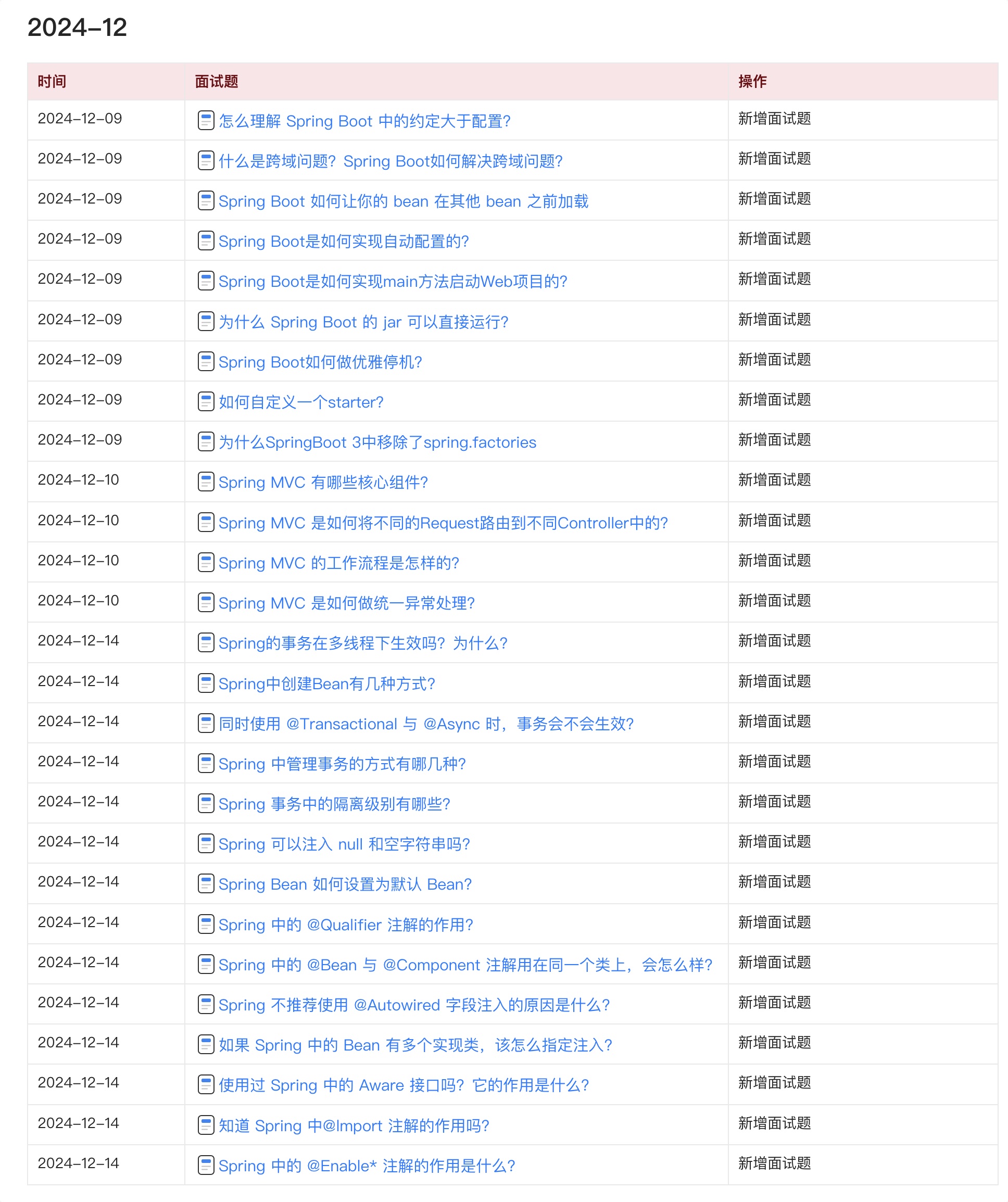Spring Security源码解析

spring security的基本原理之前讲解过了。这章主要看后面两个:
-
FilterSecurityInterceptor
决定该用户是否有权限访问指定的资源
-
ExceptionTranslationFilter
异常处理,如果不能访问,则处理FilterSecurityInterceptor中抛出的异常
AnonymousAuthenticationFilter
AnonymousAuthenticationFilter : 匿名过滤器,位置固定,前面所有的都走完之后,会经过该过滤器
该过滤器之前自己也是备受折磨,特别是在调试oath2的时候,在没有正确开始basic登录的时候,
就一直在抱怨,为什么会走这个呢?
看看最主要的源码:
public AnonymousAuthenticationFilter(String key) {
// 固定了用户信息和角色
this(key, "anonymousUser", AuthorityUtils.createAuthorityList("ROLE_ANONYMOUS"));
}
public AnonymousAuthenticationFilter(String key, Object principal,
List<GrantedAuthority> authorities) {
Assert.hasLength(key, "key cannot be null or empty");
Assert.notNull(principal, "Anonymous authentication principal must be set");
Assert.notNull(authorities, "Anonymous authorities must be set");
this.key = key;
this.principal = principal; // 用户信息不是一个对象,是一个字符串
this.authorities = authorities;
}
public void doFilter(ServletRequest req, ServletResponse res, FilterChain chain)
throws IOException, ServletException {
// 如果之前没有身份认证
// 则创建一个 AnonymousAuthenticationToken
// 也就是说到达 FilterSecurityInterceptor 中的时候一定有一个身份信息
if (SecurityContextHolder.getContext().getAuthentication() == null) {
SecurityContextHolder.getContext().setAuthentication(
createAuthentication((HttpServletRequest) req));
if (logger.isDebugEnabled()) {
logger.debug("Populated SecurityContextHolder with anonymous token: '"
+ SecurityContextHolder.getContext().getAuthentication() + "'");
}
}
else {
if (logger.isDebugEnabled()) {
logger.debug("SecurityContextHolder not populated with anonymous token, as it already contained: '"
+ SecurityContextHolder.getContext().getAuthentication() + "'");
}
}
chain.doFilter(req, res);
}
protected Authentication createAuthentication(HttpServletRequest request) {
AnonymousAuthenticationToken auth = new AnonymousAuthenticationToken(key,
principal, authorities);
auth.setDetails(authenticationDetailsSource.buildDetails(request));
return auth;
}
FilterSecurityInterceptor
看源码技巧:找准一个关键入口,然后分析调用关系和类图

-
FilterSecurityInterceptor
-
AccessDecisionManager 管理什么呢?AccessDecisionVoter :投票者
就是用来一系列的判定,是否可以进行访问什么的
-
AffirmativeBased 只要有一票否决则不能访问 (默认使用)
在未登录的时候用的是只要有一个拒绝则不能访问,在登录后,只要有一个允许则放行。。有点懵逼
-
ConsensusBased 通过/不通过 哪一个票数多就遵循哪一个
-
UnanimousBased 只要有一票否决则不允许访问
-
-
AccessDecisionVoter 投票者 spring3-,由一堆实现类来解决
- WebExpressionVoter spring3+ 由该类全部包办,它投过就过,不过就不过
-
——– 以上是三个核心的类———
-
SecurityConfig 所有的配置信息
-
ConfigAttribute 对应了每一个url的配置信息
-
SecurityContextHolder
-
Authentication 用户身份信息,用户拥有的权限信息
主流程:拿到 配置信息,用户身份信息,请求信息 然后给投票者进行投票;最后根据策略进行决定是否放行
从两个流程进行分析:
- 未登录访问被拦截
- 登录后访问
未登录访问被拦截
访问: http://localhost:8080/user/1
public class FilterSecurityInterceptor extends AbstractSecurityInterceptor implements
Filter {
public void doFilter(ServletRequest request, ServletResponse response,
FilterChain chain) throws IOException, ServletException {
// 拿到请求和响应封装成一个 invocation(调用)
FilterInvocation fi = new FilterInvocation(request, response, chain);
invoke(fi);
}
public void invoke(FilterInvocation fi) throws IOException, ServletException {
// 保证每次请求只被检查一次,依据就是 request中的 FILTER_APPLIED
if ((fi.getRequest() != null)
&& (fi.getRequest().getAttribute(FILTER_APPLIED) != null)
&& observeOncePerRequest) {
// filter already applied to this request and user wants us to observe
// once-per-request handling, so don't re-do security checking
fi.getChain().doFilter(fi.getRequest(), fi.getResponse());
}
else {
// 如果是第一次经过该过滤器,则设置标记
// first time this request being called, so perform security checking
if (fi.getRequest() != null && observeOncePerRequest) {
fi.getRequest().setAttribute(FILTER_APPLIED, Boolean.TRUE);
}
// 权限的校验
InterceptorStatusToken token = super.beforeInvocation(fi);
// 如果校验通过则是执行真正的服务了
try {
fi.getChain().doFilter(fi.getRequest(), fi.getResponse());
}
finally {
super.finallyInvocation(token);
}
super.afterInvocation(token, null);
}
}
}
// 抽象父类
public abstract class AbstractSecurityInterceptor implements InitializingBean,
ApplicationEventPublisherAware, MessageSourceAware {
protected InterceptorStatusToken beforeInvocation(Object object) {
Assert.notNull(object, "Object was null");
final boolean debug = logger.isDebugEnabled();
if (!getSecureObjectClass().isAssignableFrom(object.getClass())) {
throw new IllegalArgumentException(
"Security invocation attempted for object "
+ object.getClass().getName()
+ " but AbstractSecurityInterceptor only configured to support secure objects of type: "
+ getSecureObjectClass());
}
// 获取配置信息中对访问的url匹配的权限
// 这里会返回 hasRole('ROLE_ADMIN') ,也就是之前配置的admin角色
Collection<ConfigAttribute> attributes = this.obtainSecurityMetadataSource()
.getAttributes(object);
if (attributes == null || attributes.isEmpty()) {
if (rejectPublicInvocations) {
throw new IllegalArgumentException(
"Secure object invocation "
+ object
+ " was denied as public invocations are not allowed via this interceptor. "
+ "This indicates a configuration error because the "
+ "rejectPublicInvocations property is set to 'true'");
}
if (debug) {
logger.debug("Public object - authentication not attempted");
}
publishEvent(new PublicInvocationEvent(object));
return null; // no further work post-invocation
}
if (debug) {
logger.debug("Secure object: " + object + "; Attributes: " + attributes);
}
if (SecurityContextHolder.getContext().getAuthentication() == null) {
credentialsNotFound(messages.getMessage(
"AbstractSecurityInterceptor.authenticationNotFound",
"An Authentication object was not found in the SecurityContext"),
object, attributes);
}
// 获取身份信息
Authentication authenticated = authenticateIfRequired();
// Attempt authorization 尝试授权,也就是投票
try {
// accessDecisionManager 的实现是 AffirmativeBased,里面只有一个 WebExpressionVoter
// 如果没有通过就会抛出异常
this.accessDecisionManager.decide(authenticated, object, attributes);
}
catch (AccessDeniedException accessDeniedException) {
publishEvent(new AuthorizationFailureEvent(object, attributes, authenticated,
accessDeniedException));
// 在这里异常会被 org.springframework.security.web.access.ExceptionTranslationFilter#doFilter 捕获到
throw accessDeniedException;
}
if (debug) {
logger.debug("Authorization successful");
}
if (publishAuthorizationSuccess) {
publishEvent(new AuthorizedEvent(object, attributes, authenticated));
}
// Attempt to run as a different user
Authentication runAs = this.runAsManager.buildRunAs(authenticated, object,
attributes);
if (runAs == null) {
if (debug) {
logger.debug("RunAsManager did not change Authentication object");
}
// no further work post-invocation
return new InterceptorStatusToken(SecurityContextHolder.getContext(), false,
attributes, object);
}
else {
if (debug) {
logger.debug("Switching to RunAs Authentication: " + runAs);
}
SecurityContext origCtx = SecurityContextHolder.getContext();
SecurityContextHolder.setContext(SecurityContextHolder.createEmptyContext());
SecurityContextHolder.getContext().setAuthentication(runAs);
// need to revert to token.Authenticated post-invocation
return new InterceptorStatusToken(origCtx, true, attributes, object);
}
}
}
// 默认投票策略
public class AffirmativeBased extends AbstractAccessDecisionManager {
public AffirmativeBased(List<AccessDecisionVoter<? extends Object>> decisionVoters) {
super(decisionVoters);
}
public void decide(Authentication authentication, Object object,
Collection<ConfigAttribute> configAttributes) throws AccessDeniedException {
int deny = 0;
for (AccessDecisionVoter voter : getDecisionVoters()) {
// WebExpressionVoter 去投票
int result = voter.vote(authentication, object, configAttributes);
if (logger.isDebugEnabled()) {
logger.debug("Voter: " + voter + ", returned: " + result);
}
switch (result) {
// 如果 是允许访问,则立即返回,也就是只要有一个同意则放行
case AccessDecisionVoter.ACCESS_GRANTED:
return;
// 如果返回的是拒绝则计数
case AccessDecisionVoter.ACCESS_DENIED:
deny++;
break;
default:
break;
}
}
// 如果没有允许访问,则判定是否是被拒绝了。
// 被拒绝则异常给调用者
if (deny > 0) {
throw new AccessDeniedException(messages.getMessage(
"AbstractAccessDecisionManager.accessDenied", "Access is denied"));
}
// To get this far, every AccessDecisionVoter abstained
checkAllowIfAllAbstainDecisions();
}
}
public class ExceptionTranslationFilter extends GenericFilterBean {
public void doFilter(ServletRequest req, ServletResponse res, FilterChain chain)
throws IOException, ServletException {
HttpServletRequest request = (HttpServletRequest) req;
HttpServletResponse response = (HttpServletResponse) res;
try {
chain.doFilter(request, response);
logger.debug("Chain processed normally");
}
catch (IOException ex) {
throw ex;
}
catch (Exception ex) {
// Try to extract a SpringSecurityException from the stacktrace
Throwable[] causeChain = throwableAnalyzer.determineCauseChain(ex);
// 获取到异常链中,第一次抛出的是否是身份异常信息
RuntimeException ase = (AuthenticationException) throwableAnalyzer
.getFirstThrowableOfType(AuthenticationException.class, causeChain);
if (ase == null) {
// 这一次流程是未登录访问
// 所以是被拒绝访问的异常
ase = (AccessDeniedException) throwableAnalyzer.getFirstThrowableOfType(
AccessDeniedException.class, causeChain);
}
if (ase != null) {
// 检测响应是否已经提交
// 提交过得响应已经写了 http状态码和响应头
if (response.isCommitted()) {
throw new ServletException("Unable to handle the Spring Security Exception because the response is already committed.", ex);
}
// 处理安全异常
handleSpringSecurityException(request, response, chain, ase);
}
else {
// Rethrow ServletExceptions and RuntimeExceptions as-is
if (ex instanceof ServletException) {
throw (ServletException) ex;
}
else if (ex instanceof RuntimeException) {
throw (RuntimeException) ex;
}
// Wrap other Exceptions. This shouldn't actually happen
// as we've already covered all the possibilities for doFilter
throw new RuntimeException(ex);
}
}
}
private void handleSpringSecurityException(HttpServletRequest request,
HttpServletResponse response, FilterChain chain, RuntimeException exception)
throws IOException, ServletException {
if (exception instanceof AuthenticationException) {
logger.debug(
"Authentication exception occurred; redirecting to authentication entry point",
exception);
sendStartAuthentication(request, response, chain,
(AuthenticationException) exception);
}
else if (exception instanceof AccessDeniedException) {
Authentication authentication = SecurityContextHolder.getContext().getAuthentication();
if (authenticationTrustResolver.isAnonymous(authentication) || authenticationTrustResolver.isRememberMe(authentication)) {
logger.debug(
"Access is denied (user is " + (authenticationTrustResolver.isAnonymous(authentication) ? "anonymous" : "not fully authenticated") + "); redirecting to authentication entry point",
exception);
// 如果是 Anonymous 身份信息,又是拒绝访问异常
// 则发送,并开始授权
sendStartAuthentication(
request,
response,
chain,
new InsufficientAuthenticationException(
messages.getMessage(
"ExceptionTranslationFilter.insufficientAuthentication",
"Full authentication is required to access this resource")));
}
else {
logger.debug(
"Access is denied (user is not anonymous); delegating to AccessDeniedHandler",
exception);
accessDeniedHandler.handle(request, response,
(AccessDeniedException) exception);
}
}
}
protected void sendStartAuthentication(HttpServletRequest request,
HttpServletResponse response, FilterChain chain,
AuthenticationException reason) throws ServletException, IOException {
SecurityContextHolder.getContext().setAuthentication(null);
requestCache.saveRequest(request, response);
logger.debug("Calling Authentication entry point.");
// org.springframework.security.web.authentication.LoginUrlAuthenticationEntryPoint#commence
// 该类是我们之前配置的 loginFormUrl = /authentication/require 的处理器端点
// 该端点会获取到 之前配置的地址然后使用
// redirectStrategy.sendRedirect(request, response, redirectUrl); 进行跳转
// 该访问之后就完成了拒绝并引导授权的功能
authenticationEntryPoint.commence(request, response, reason);
}
}
登录后访问
该源码就不记录了。篇幅太多了;
Java 面试宝典是大明哥全力打造的 Java 精品面试题,它是一份靠谱、强大、详细、经典的 Java 后端面试宝典。它不仅仅只是一道道面试题,而是一套完整的 Java 知识体系,一套你 Java 知识点的扫盲贴。
它的内容包括:
- 大厂真题:Java 面试宝典里面的题目都是最近几年的高频的大厂面试真题。
- 原创内容:Java 面试宝典内容全部都是大明哥原创,内容全面且通俗易懂,回答部分可以直接作为面试回答内容。
- 持续更新:一次购买,永久有效。大明哥会持续更新 3+ 年,累计更新 1000+,宝典会不断迭代更新,保证最新、最全面。
- 覆盖全面:本宝典累计更新 1000+,从 Java 入门到 Java 架构的高频面试题,实现 360° 全覆盖。
- 不止面试:内容包含面试题解析、内容详解、知识扩展,它不仅仅只是一份面试题,更是一套完整的 Java 知识体系。
- 宝典详情:https://www.yuque.com/chenssy/sike-java/xvlo920axlp7sf4k
- 宝典总览:https://www.yuque.com/chenssy/sike-java/yogsehzntzgp4ly1
- 宝典进展:https://www.yuque.com/chenssy/sike-java/en9ned7loo47z5aw
目前 Java 面试宝典累计更新 400+ 道,总字数 42w+。大明哥还在持续更新中,下图是大明哥在 2024-12 月份的更新情况:

想了解详情的小伙伴,扫描下面二维码加大明哥微信【daming091】咨询

同时,大明哥也整理一套目前市面最常见的热点面试题。微信搜[大明哥聊 Java]或扫描下方二维码关注大明哥的原创公众号[大明哥聊 Java] ,回复【面试题】 即可免费领取。

